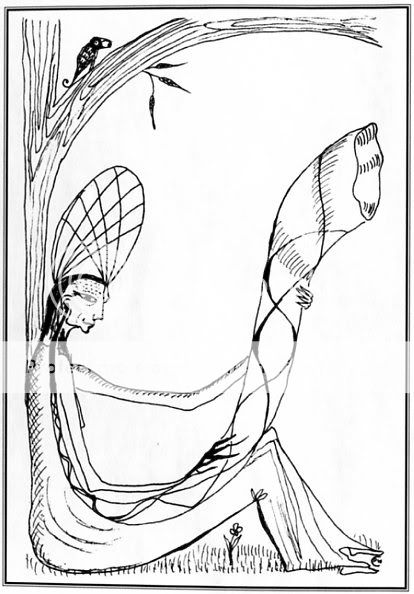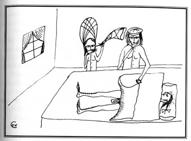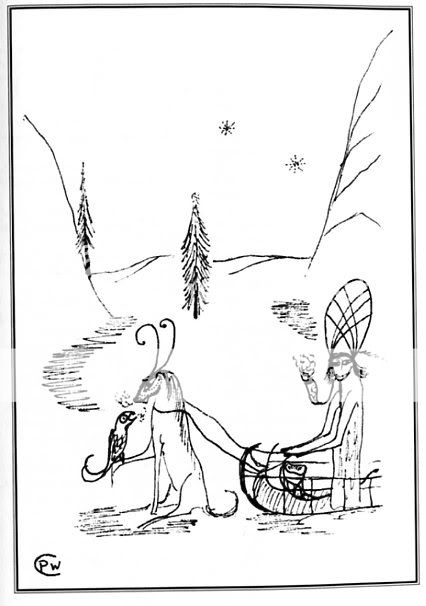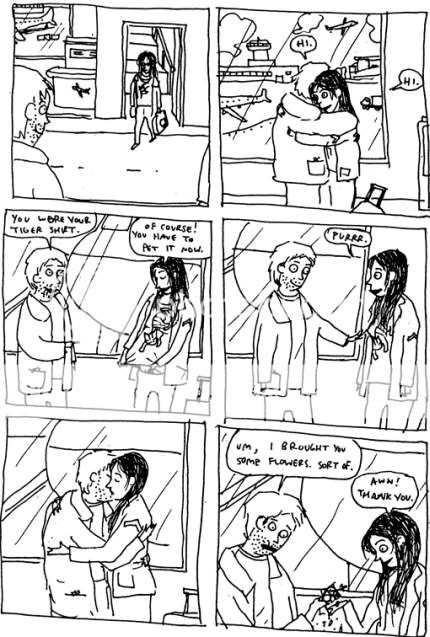Vom Marlowe did a post last week about the virtues of the stick figure art in xkcd. She noted:
See, I think there’s a lot to be said for simplicity and humor and just plain getting the point across. The art needs to serve the point of the communication. Some of the, hmmm, shall we say overmuscled super hero comics seem to miss the idea that the art needs to communicate as much as the words do.
I have a lot of sympathy with that sentiment. Mostly that’s probably because…well, here’s one of my own drawings from my zine “The Adventures of Eustacia H. Cow.”

That’s a cow spanking a sentient toaster. Just in case it wasn’t clear.
Putting aside my own individual bias, though, there’s just a lot of great drawing that looks more or less like it could have been done by a 6 year old. One of the best examples I came across recently was the book “The Hearing Trumpet,” by Leonora Carrington. Carrington is best known as a surrealist painter; born in England, she had a relationship with Max Ernst, and then moved to Mexico, where she became good friends with the amazing painter Remedios Varos. (According to Wikipedia, she’s still alive, too! She’s 92, I guess.)
Anyway, “The Hearing Trumpet” as a novel is something of a mixed bag. It starts off as being about an elderly woman named Marian Leatherby. The everyday, mildly absurd details of Marian’s life, and of her friend Carmella, are thoroughly delightful, adn the writing has that distintively English low-key nuttiness that puts it firmly in the tradition of P.G. Wodehouse and Douglas Adams. Carmella’s explanation of why Marian needs a hearing trumpet in order to overcome her deafness and spy on her family is priceless.
“You never know,” said Carmella. “People under seventy and over seven are very unreliable if they are not cats. You can’t be too careful. Besides, think of the exhilarating power of listening to others talk when they think you cannot hear.”
“They can hardly avoid seeing the trumpet,” I said doubtfully. “It must be a buffalo’s horn. Buffalos are very large animals.”
“Of course you must not let them see you using it, you have to hide somewhere and listen.” I hadn’t thought of that, it certainly presented infinite possibilities.
A whole book of that would make me happy. Unfortunately, “The Hearing Trumpet” is a bit like Promethea; entertaining through about the first half, then the author gets distracted by tediously crankish alchemical meanderings and the temptations of religio-mystico profundity. So it goes.
Anyway, I was originally talking about the art. Here’s a bunch of elderly ladies doing exercises, including Marian, who has set her era trumpet down off to the side.
There’s some of Edward Gorey’s sketchiness there, but without his sophistication or elegance. Instead, the proportions seem to elongate or contract to suit the artist’s fancy; the woman with the turban (who I believe is Marian) has arms that are as long as her entire body. I love the little hint of motion lines as well; it makes the movements seem as scratchy and idiosyncratic as the figures themselves. And all the scribbles, on the ground, or in the tree indicating the leaves — it’s just very energetic and personable.
Or this is great too
That has to be about the most economically rendered transvestite revelation scene ever. The reactions of the two women watching are cleverly differentiated as well, just by slightly changing the positioning of their hands against their faces. I love the way the room itself is sketched too; just three wavery lines to make the corner, and then the more detailed window, so flat and blank it might as well be a picture of a window.
Here’s another:
It’s all still very stick-figure, obviously, but you can tell she can really draw. The way the bottom of the sled curves up is elegantly done, and that bird is made up of some deceptively fluid lines. Even the little dots of breath coming out of the animals’ mouths are pleasingly arranged in half semicircles…and the small dots on the deer(?)’s face are very nice as well.
Of course, simple drawing doesn’t always work:
Dilbert’s a very simple strip — yet it’s also off-puttingly slick. There’s none of the sense of quick whimsy you get in Carrington’s drawings. You’d think if you were drawing a demon a little flair or wildness might be in order, but nope; it doesn’t even really have any expression, nor does it move from panel to panel. The characters look like they’re designed on computer…which maybe they are (no, I”m not going to research Scott Adams’ technique. I mean, for God’s sake, who cares?)
Jeff Brown’s work, on the other hand, doesn’t look slick— but it’s also just really ugly. I think, looking at it in comparison to the Carrington drawings, a lot of the problem is actually how cluttered this is. The shapes defining the window in the middle two panels for example. What do those add? It just makes it look like a mess. The linework also seems more labored than graceful. It’s like he’s trying to get everything in without thinking about how it looks. The narrative is driving the story, and his art is just struggling to keep up, rather than running with his sketchy style and trying to see where that can take him.
(To be fair, this is a somewhat older strip, and I think recently Brown has actually gotten better at both simplifying and at drawing; some of the more recent work on his site is…not great, but not terrible either. There’s nothing especially wrong with this Simpsons pastiche, for example.)
So, yeah, I guess I have to admit that, much as I might like it to be true, just because you can’t draw doesn’t mean you’ll make great art.
Leonara Carrington still kicks Alex Ross’ ass, though.






